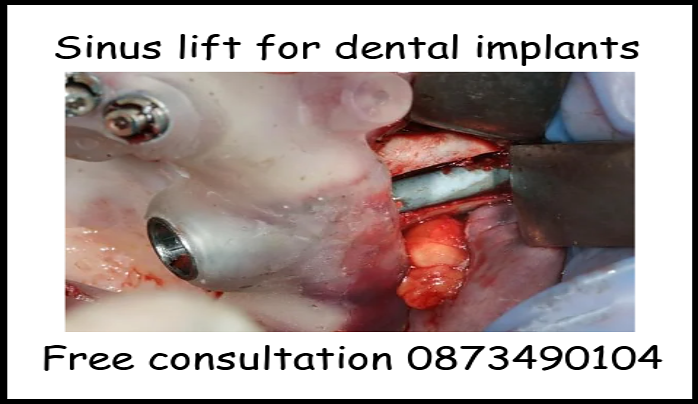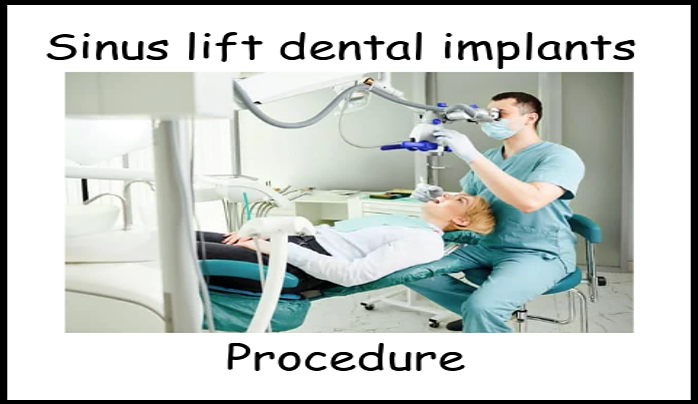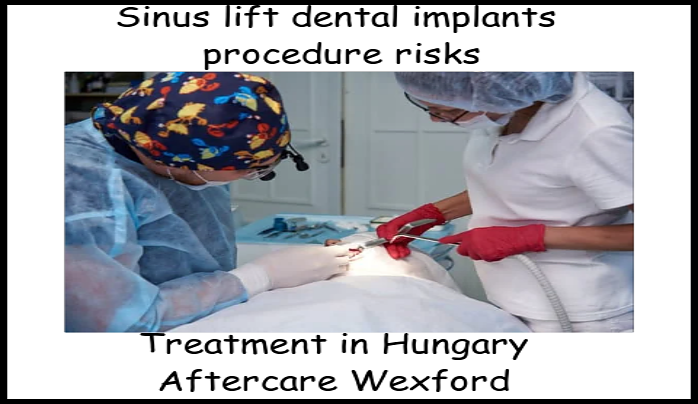Sinus lift for dental implants
A sinus lift for dental implants may be essential for patients that have insufficient jawbone to support dental implants.
This very specialized dental surgery treatment is carried out in order to augment the lower or the upper jaw before the placement of dental implants.
It is a necessary treatment for patients with inadequate bone height in the posterior region of the upper jaw, where the sinus cavity is located.
In this article, we will delve into the details of the sinus lift procedure, its benefits, and considerations.

1. What is a sinus lift procedure?
A sinus lift for dental implants, also known as a sinus augmentation, is a surgical procedure that aims to raise the sinus floor and create additional space for dental implants.
This procedure helps in building up the bone height in the area, allowing for successful implant placement.
2. Who needs a sinus lift?
Patients who have experienced bone loss in the upper jaw due to tooth loss, periodontal disease, or other factors often require a sinus lift before receiving dental implants.
Insufficient bone height can limit the stability and effectiveness of implants, making a sinus lift for dental implants an essential preparatory procedure.
3. How is the sinus lift procedure performed?
The sinus lift procedure is typically performed by an oral surgeon or a specialized dental implantologist. The process involves the following steps:
– The surgeon will create an incision in the gum tissue so as to expose the underlying jawbone.
– A tiny area is opened up in the jawbone to allow access to the sinus cavity.
– The sinus membrane is gently lifted, and a bone graft material is placed in the space created beneath it.
– Once the bone graft is in place, the incision is closed, and the healing process begins.
Call us at Hungarian Dental implant Centre Wexford for a free sinus lift for dental implants consultation and cost on 0873490104.
4. What materials are used for bone grafting?
Bone graft materials used in sinus lift for dental implants procedures can be synthetic, obtained from animals (xenograft), or taken from the patient’s own bone (autograft).
The choice of graft material depends on various factors, including the patient’s preference, overall health, and the surgeon’s recommendation.
5. Recovery and post-operative care:
Following a sinus lift procedure, patients may experience swelling, mild discomfort, and nasal congestion for a few days.
Pain medications and antibiotics may be prescribed to alleviate any discomfort and prevent infection.
It is crucial to follow post-operative instructions provided by the dentist or oral surgeon to ensure proper healing.

6. Benefits of the sinus lift procedure:
– Increases bone height:
The sinus lift for dental implants procedure allows for the creation of sufficient bone height in the upper jaw, enabling successful placement of dental implants.
– Enhanced stability:
By increasing bone volume, the sinus lift procedure significantly improves the stability and longevity of dental implants.
– Improved aesthetics and function:
Once the dental implants are successfully placed, patients can regain their confident smile, improved speech, and efficient chewing.
Types of sinus lift for dental implants
There are generally two types of sinus lift for dental implants procedures that are commonly employed in dental implant surgery.
These procedures aim to increase the bone volume in the upper jaw, specifically in the area of the maxillary sinus, to provide a stable foundation for dental implant placement.
The types of sinus lift procedures available are as follows:
1. Direct Sinus Lift (also known as the Osteotome Technique or Internal Sinus Lift):
This procedure is typically used when there is a minimal bone loss in the posterior maxilla.
It involves accessing the sinus cavity through the natural opening and gently pushing up the sinus membrane.
Specialized instruments, such as osteotomes, are then used to elevate the sinus floor by packing bone graft material beneath it.
The bone graft material will eventually integrate with the surrounding bone, providing adequate support for dental implants.
2. Indirect Sinus Lift (also known as the Lateral Window Technique or External Sinus Lift):
This procedure is performed when there is significant bone loss in the posterior maxilla, making it impossible to perform a direct sinus lift.
It involves creating a small window in the lateral wall of the sinus, exposing the sinus membrane.
The sinus membrane is then carefully lifted, and bone graft material is placed in the created space.
Once the bone graft material integrates with the existing bone, dental implants can be placed in the augmented area.
Both procedures, direct and indirect sinus lifts, are effective techniques that aid in the successful placement of dental implants.
The choice of procedure depends on the amount of bone loss and the individual patient’s specific needs.
It is important to consult with a qualified oral surgeon or implantologist to evaluate which sinus lift technique is most suitable for your case.
Call us at Hungarian Dental implant Centre Wexford for a free sinus lift for dental implants consultation and cost on 0873490104.
What types of grafting materials are used for a sinus lift
In a sinus lift for dental implants procedure, a variety of grafting materials can be used to promote bone growth and provide stability for the implant. T
he choice of grafting material depends on several factors, including the patient’s specific needs, the surgeon’s preference, and the availability of materials.
One commonly used grafting material is autogenous bone grafts, which involve taking bone from another area of the patient’s body, such as the chin or hip, and placing it in the sinus area.
Autogenous bone grafts are often considered the gold standard due to their osteogenic, osteoinductive, and osteoconductive properties.
Another option is allografts, which are grafting materials sourced from a different individual of the same species, typically from a donor.
Allografts can be in the form of frozen or freeze-dried bone, or demineralized bone matrix, and they provide a scaffold for new bone growth.
Xenografts, derived from animal sources such as bovine (cow) or porcine (pig) bone, are also utilized.
These grafting materials are processed to remove any organic or biological components, reducing the risk of rejection or disease transmission.
Xenografts serve as a framework for new bone formation.
Synthetic grafts are another option, including materials such as hydroxyapatite, tricalcium phosphate, or bioactive glasses.
These materials mimic natural bone and provide a scaffold for bone regeneration, promoting the migration and attachment of bone cells.
In some cases, a combination of grafting materials may be used to enhance bone regeneration.
This approach may involve a mixture of autogenous bone grafts with allografts or xenografts, providing the benefits of both materials.
It is important to note that the choice of grafting material depends on the specific needs and preferences of the patient, as well as the clinical judgment of the dental professional performing the sinus lift procedure.

What are the risks in a sinus lift for implants
There are certain risks associated with sinus lift for dental implants procedure.
While these risks are relatively low, it is important to take them into consideration before undergoing the procedure.
It is always advisable to consult with your dentist or oral surgeon to thoroughly understand the potential risks and benefits.
Some of the more common risks include:
1. Infection:
I’m sure that most people know, any surgical procedure will carry a risk of causing infection. A sinus lift for dental implants is no exception.
The surgical site may become infected if proper post-operative care is not followed.
2. Sinus complications: Since sinus lift involves raising the sinus membrane, there is a possibility of sinus-related complications.
These may include sinusitis, sinus congestion, or even a small tear in the sinus lining.
3. Nerve injury:
The maxillary sinus is in close proximity to important nerves, such as the infraorbital nerve.
Although rare, there is a small risk of nerve injury during the sinus lift procedure, which may result in numbness, tingling, or altered sensation in the face, teeth, or gums.
4. Graft failure:
Sinus lift for dental implants treatment involves placing a bone graft in the sinus cavity to create a stable foundation for dental implants.
However, there is a risk that the graft may not integrate properly with the existing bone, leading to graft failure and compromised implant success.
5. Bleeding and swelling:
As with any surgery, bleeding and swelling are common post-operative side effects.
While they are usually temporary and manageable, excessive bleeding or severe swelling should be reported to your oral surgeon.
It is worth noting that these risks can be minimized by choosing a skilled and experienced oral surgeon, following proper pre and post-operative instructions, and maintaining good oral hygiene.
Your dentist will thoroughly evaluate your specific case and provide tailored advice regarding the potential risks and benefits of sinus lift surgery for dental implants.
Call us at Hungarian Dental implant Centre Wexford for a free sinus lift for dental implants consultation and cost on 0873490104.

Options to sinus lift for dental implants
Sinus lift is a common dental procedure that may be necessary in cases where there is insufficient bone height in the upper jaw to support dental implants.
However, not all patients may be suitable candidates for a sinus lift or may want to explore alternative options.
Here are some alternatives to a sinus lift for dental implants:
1. Short Implants:
In cases where the available bone height is limited, shorter implants can be used instead of traditional implants.
Short implants are specifically designed to provide stability and support in areas with less bone.
2. Zygomatic Implants:
Zygomatic implants are longer implants that anchor into the cheekbone (zygomatic bone) instead of the maxillary bone.
This technique is reserved for patients with severe bone loss in the upper jaw and provides an alternative solution without the need for a sinus lift.
3. All-on-4 or All-on-6 Implants:
This treatment approach involves placing a fixed bridge or denture supported by four or six strategically placed implants in the jaw.
By angling the implants, it may be possible to avoid the need for a sinus lift.
4. Mini Implants:
Mini implants are smaller in diameter and can be an alternative for patients with limited bone height.
They are not suitable for all cases, but your dentist can evaluate if they are a viable option for you.
5. Bone grafting:
In some cases, bone grafting procedures can be performed to build up the bone in the sinus area prior to dental implant placement.
This option may be suitable for patients who desire traditional dental implants and have sufficient time for the bone grafting and healing process.
It’s important to note that the suitability of these alternatives depends on individual factors such as the quality and quantity of bone, overall oral health, and the specific needs of the patient.
Consulting with a qualified dentist or oral surgeon is crucial to determine the best treatment plan for your specific situation.

What happens during a sinus lift procedure
During a sinus lift procedure for dental implants, several important steps are taken to ensure the successful placement of the implants.
This surgical procedure is typically performed by an oral and maxillofacial surgeon or a periodontist.
Let’s explore what happens during a sinus lift procedure in a professional manner.
1. Preoperative Assessment:
– A comprehensive evaluation of the patient’s dental and medical history is conducted to determine their suitability for the procedure.
– Diagnostic imaging, such as X-rays or CT scans, is performed to assess the anatomy and condition of the sinuses, jawbone, and existing teeth.
2. Anesthesia:
– Local anesthesia is administered to numb the surgical area, ensuring that the patient remains comfortable throughout the procedure.
– Sometimes, sedation or general anesthesia may be used to further enhance patient comfort, especially for complex or lengthy procedures.
3. Incision and Exposure:
– An incision is made in the gum tissue near the area where the dental implants will be placed.
– The surgeon carefully lifts the gum tissue, creating a small flap to expose the underlying jawbone.
4. Preparation of the Sinus Cavity:
– A small window is created in the bone to access the sinus cavity located above the jaw.
– The lining of the sinus is gently lifted, creating space for the bone graft material to be placed.
5. Bone Grafting:
– The bone graft material, which is usually either synthetic or obtained from the patient’s own body, is placed into the newly created space within the sinus cavity.
– The bone graft material helps stimulate new bone growth, increasing the height and volume of the jawbone, which is crucial for the successful placement and stability of dental implants.
6. Implant Placement:
– After an appropriate healing period, during which the bone graft material integrates with the existing bone, the dental implants can be placed.
– The implants are carefully positioned into the augmented bone, providing a stable foundation for the prosthetic teeth or dentures.
7. Closure:
– Once the implants are securely in place, the incision is sutured closed, promoting proper healing.
– The gum tissue is carefully repositioned to cover the surgical site, allowing for a natural-looking aesthetic outcome.
8. Postoperative Care:
– Patients are typically prescribed antibiotics and pain medications to manage any discomfort and minimize the risk of infection.
– Postoperative instructions, including guidelines for oral hygiene practices and dietary restrictions, are provided to ensure proper healing.
It is important to note that every patient’s situation may vary, and the sinus lift procedure may be customized to meet their specific needs.
Following the sinus lift procedure, patients will undergo a healing period before the dental implants can be loaded with replacement teeth.
Regular follow-up appointments will be scheduled to monitor the healing process and ensure the long-term success of the dental implant rehabilitation.
Please consult with a dental professional for personalized advice regarding the sinus lift procedure and dental implant treatment options.
Call us at Hungarian Dental implant Centre Wexford for a free sinus lift for dental implants consultation and cost on 0873490104.
Conclusion:
The sinus lift for dental implants procedure is a vital preparatory step in the journey towards restoring a healthy and functional smile.
With a better understanding of this procedure, patients can make informed decisions and work closely with their dental professionals to achieve optimal results.
If you are considering dental implants and have insufficient bone height in your upper jaw, consult with a qualified dentist or oral surgeon who can determine the suitability of a sinus lift for you.
References
https://pubmed.ncbi.nlm.nih.gov/20467595/
https://pubmed.ncbi.nlm.nih.gov/29763503/
https://www.sciencedirect.com/science/article/pii/S090150272100126

